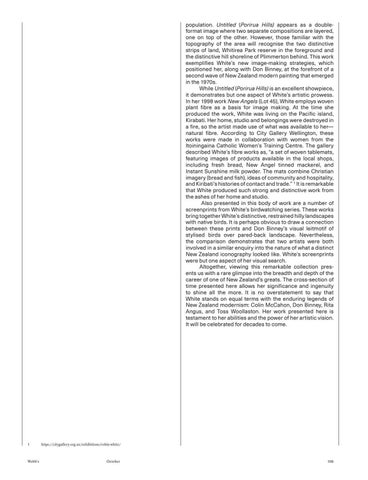population. Untitled (Porirua Hills) appears as a doubleformat image where two separate compositions are layered, one on top of the other. However, those familiar with the topography of the area will recognise the two distinctive strips of land, Whitirea Park reserve in the foreground and the distinctive hill shoreline of Plimmerton behind. This work exemplifies White’s new image-making strategies, which positioned her, along with Don Binney, at the forefront of a second wave of New Zealand modern painting that emerged in the 1970s. While Untitled (Porirua Hills) is an excellent showpiece, it demonstrates but one aspect of White’s artistic prowess. In her 1998 work New Angels (Lot 45), White employs woven plant fibre as a basis for image making. At the time she produced the work, White was living on the Pacific island, Kirabati. Her home, studio and belongings were destroyed in a fire, so the artist made use of what was available to her— natural fibre. According to City Gallery Wellington, these works were made in collaboration with women from the Itoiningaina Catholic Women’s Training Centre. The gallery described White’s fibre works as, “a set of woven tablemats, featuring images of products available in the local shops, including fresh bread, New Angel tinned mackerel, and Instant Sunshine milk powder. The mats combine Christian imagery (bread and fish), ideas of community and hospitality, and Kiribati’s histories of contact and trade.” 1 It is remarkable that White produced such strong and distinctive work from the ashes of her home and studio. Also presented in this body of work are a number of screenprints from White’s birdwatching series. These works bring together White’s distinctive, restrained hilly landscapes with native birds. It is perhaps obvious to draw a connection between these prints and Don Binney’s visual leitmotif of stylised birds over pared-back landscape. Nevertheless, the comparison demonstrates that two artists were both involved in a similar enquiry into the nature of what a distinct New Zealand iconography looked like. White’s screenprints were but one aspect of her visual search. Altogether, viewing this remarkable collection presents us with a rare glimpse into the breadth and depth of the career of one of New Zealand’s greats. The cross-section of time presented here allows her significance and ingenuity to shine all the more. It is no overstatement to say that White stands on equal terms with the enduring legends of New Zealand modernism: Colin McCahon, Don Binney, Rita Angus, and Toss Woollaston. Her work presented here is testament to her abilities and the power of her artistic vision. It will be celebrated for decades to come.
1 https://citygallery.org.nz/exhibitions/robin-white/
Webb's
October
106







